
One of the key attractions of Expo Milano 2015, and a first in terms of Universal Expositions, the Clusters bring together communities, not by geographical area, but by a common theme and food group.
Here we look at the Expo theme, Feeding the Planet, Energy for Life, in its broadest sense, in a spirit of sharing, dialogue and interaction.
Rice Cluster – Abundance and Security

A rural landscape that conveys the feel of the vastness, the colors, and scents of rice fields, greets visitors as they begin their journey into the world of rice. One of the first cereals to be cultivated by humankind, rice has since spread worldwide, far beyond its early origins in the valleys of China.

Within this Cluster, visitors will be immersed in a rural setting made possible by a Kaleidoscope effect, created by mirrors. The visitor will enter a botanical area that contains different varieties of rice growing in paddy fields, to offer an authentic experience. The visitor will also have the opportunity to engage in interactive games within this area, made possible through the use of plasma screens situated next to the water tanks. These screens will offer stories of legends, myths and statistical information about rice and its cultivation, to give the visitor both an authentic and educational experience at the same time. The option to try actual rice products will also be possible via the many kiosks situated throughout the public area.
COUNTRIES IN THE CLUSTER:
Bangladesh, Cambodia, Lao People’s Democratic Republic, Myanmar,
Sierra Leone.

Cocoa and Chocolate Cluster - The Food of Gods

Chocolate is made from cocoa beans, and these come from the small, fruit-bearing cacao tree. Measuring just over ten centimeters, the cacao tree is grown in tropical and subtropical plantations, and these provide the inspiration for this pavilion.


Upon entering the Cocoa and Chocolate Cluster, visitors will feel as if they are walking into the jungle. The Cluster is based on the concept of recreating the environment in which cacao trees grow, on tropical and subtropical plantations. The external parts of the buildings are made of very light materials, which open slightly to reveal the internal canopy. This design symbolizes the need to protect such a valuable and aromatic product as cocoa.
The Cocoa and Chocolate Cluster contains a large number of poles of differing sizes, which represent the large and varying species of trees under which cacao trees grows. The atmosphere is dense and warm as in a real jungle, where sunlight penetrates the trees’ crowns and casts its rays down through the pavilions.
EUROCHOCOLATE / Official Cocoa and Chocolate cluster content provider
COUNTRIES IN THE CLUSTER: Cameroon, Côte D'Ivoire, Cuba, Gabon, Ghana, Sao Tome and Principe
Coffee Cluster - The Engine of Ideas

Starting life as the seeds of tropical plants that are harvested, dried and then roasted, this aromatic beverage warms and revives. Inspiring this Cluster are the vast coffee plantations set in the shade of the tropical forests of Africa and Central America.


The Coffee Cluster curated by illycaffè takes visitors on an exhibition path “from the land to the coffee-cup”, expressed via five main stops: the greenhouse, the transportation, the bar and the meeting area. The path starts outside the pavilion in the green area, decorated with coffee plants – stage for the splendid photographic exhibition by Sebastião Salgado.
Once inside the refreshment area, visitors can enjoy aromatic and delicious coffee. In the events area there will be a number of meetings, presentations and shows. Between the bar and the events area, visitors will find the market area where they can buy coffee products from different countries, as a keepsake and reminder of the aromas and flavors they have experienced.
COUNTRIES IN THE CLUSTER:
Burundi, Costa Rica, El Salvador, Ethiopia, Guatemala, Kenya, Rwanda,
Uganda, Yemen.

Conjuring an orchard, this space accommodates both small and large varieties of fruit trees. Fruits and legumes have been eaten since ancient times. So engrained are they in many cultures worldwide, that they have often been the subject of myths, legends, and traditions.
The Fruits and Legumes Cluster contains areas cultivated with different varieties of fruit plants. Surrounding the main central square of this Cluster, the visitor is able to participate in and enjoy the events, which are inspired by the shapes, scents and colors of the large variety of fruits and legumes on offer.

Above the square, a wooden roof canopy covers the entire area and connects the pavilions. Around the exit, visitors will have the opportunity to walk around the market and perhaps purchase some of the tasty fruits and legumes that are on display. The market links this Cluster to the Spices Cluster, offering the visitor a natural path between the two, leading them nicely through to their next experience.
COUNTRIES IN THE CLUSTER:
Benin, Democratic Republic of the Congo, Equatorial Guinea, Gambia, Guinea,
Kyrgyzstan, Uzbekistan, Zambia.

A sensory experience for all, this Cluster takes its cue from the ancient spice trade routes, evoking the exotic aromas and colors of distant lands and seas. The maps that led to the discovery of, and trade in, new sources of spices are a highlight of this journey.

The exhibition area shows geographical maps that have guided explorers traveling the world in their discovery of spices, suggesting a journey through cultures which begins with a sequence of “sensorial areas” that include tastings, installations and events.
All around the world there are many areas where the cultivation, preparation and use of spices is carried out regularly, be it in medicine or for socio-cultural rituals that sometimes border on magic. The exhibition journey shows visitors all the spices that originate from the countries of this Cluster.
COUNTRIES IN THE CLUSTER:
Afghanistan, Brunei Darussalam, United Republic of Tanzania, Vanuatu.
Cereals and Tubers Cluster - Old and New Crops

The colors and fragrances reminiscent of cereal and tuber crops are the conceptual basis for this pavilion, which traces the discovery and development of crops that have brought nourishment to many peoples all over the world.

Visitors can move in the space between the pavilions, allowing themselves to be gently drawn along by the different examples of land cultivation. The canopy of the architectural project has the shape and form of a large fireplace that hosts an area for events and the distribution of themed culinary dishes.
At the end of their visit to this exhibition area, visitors can participate in a number of suggested activities or just sit and relax, enjoying the typical dishes of the countries exhibiting in this cluster.
COUNTRIES OF THE CLUSTER:
Bolivia, Congo, Haiti, Mozambique, Togo, Zimbabwe.
Bio-Mediterraneum - Health, Beauty and Harmony

The Mediterranean Sea unites Europe, Africa and Asia and is a melting pot of peoples, histories, civilizations and environments. The image of the sea within the Cluster is conveyed by a floor in many shades of blue, recalling the colors of the sea that embraces the countries hosted in this Cluster.

The countries’ pavilions in this Cluster are united by the color blue, characteristic of the Mediterranean sea. At the center of the structure, the main attraction are traditional open kitchens that represent the classic image of this region. Here, visitors will find a selection of products typical of Mediterranean cuisine: olive oil, bread and various wines. In this area visitors have the opportunity to take part in food preparation classes and attend organized show cooking programs.
The central theme of this Cluster is visual storytelling, its main storyline being Mediterranean places and food. The three sub-categories of this story are pictures, literature and cinematographic history of the Mediterranean. Some of the structures from the architectural project will play a role in the show, including a number of supports that weave their way around the 21 columns of the square, guiding the audience through the three stories.
COUNTRIES IN THE CLUSTER:
Albania, Algeria, Egypt, Greece, Lebanon, Libya, Malta, Montenegro,
San Marino, Serbia, Tunisia.

Cued by the sights, sounds, colors and scents typical of sea- and ocean-bound habitats, this Cluster evokes the sense of harmony that characterizes its member lands.

The Countries exhibiting inside this cluster are grouped together under a large bamboo canopy that stands high above, connecting the two pavilions. This creates a unique environment of colors and atmosphere. The walls of this Cluster display verses from well-known writers, such as Homer, Conrad, Columbus, Darwin and Melville, whose writings evoke thoughts of journeys made at sea and to remote desert islands.
As the visitors head towards the exit of this Cluster, they have the opportunity to enter an area that displays underwater images, giving the impression of actually being under water. This is an opportunity to experience the magical and charming yet fragile biodiversity that is characteristic of these islands and the seas that surround them.
COUNTRIES IN THE CLUSTER:
Barbados, Belize, Cape Verde, Caribbean Community, Comoros, Dominica,
Grenada, Guinea Bissau, Guyana, Madagascar, Maldives, Saint Lucia,
Saint Vincent and the Grenadines, Suriname.
Agriculture and Nutrition in the Arid Zones Cluster

Entering the Cluster, visitors feel as if they are in a desert sandstorm, this scene symbolizing both the difficulty of living in, and of exploiting, the arid and semi-arid territories, with their many hidden vital resources.

On arriving at this Cluster, the visitor is presented with a water fountain that is situated in the public area, giving the impression of a natural oasis in an arid landscape. Also within this area, visitors are provided with information through presentations and performances that highlight the challenges and resources typical of these arid environments.
As visitors leave this Cluster, they will have the opportunity to sample and purchase some of the fruits and products that grow in these arid parts of the world.
COUNTRIES IN THE CLUSTER:
Djibouti, Eritrea, Mauritania, Mali, Palestine, Senegal, Somalia.
All photo credits: ©Expo2015/Daniele Mascolo
Source: http://www.expo2015.org/en/explore/clusters



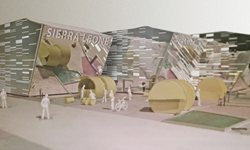 2
2
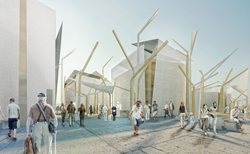 6
6
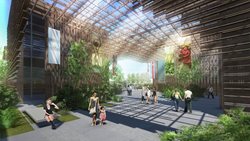 5
5
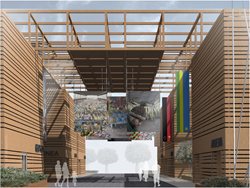 1
1
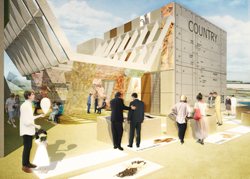 2
2
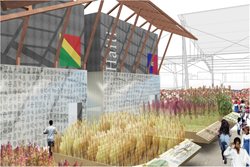 2
2
 11
11
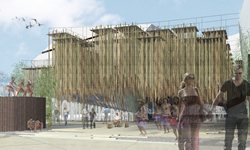 3
3
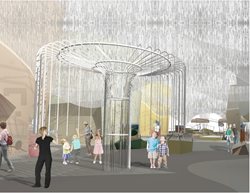 2
2
comment